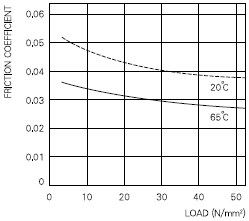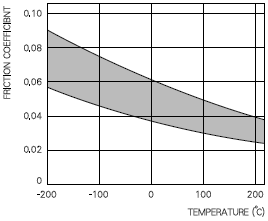Self Lubricating Liners
Spherical and Rod End bearings with PTFE Liner were first introduced in the 1950s. As it is referred "self lubricating liners", bearings equipped with PTFE Liner don't require any grease charging at all, since the PTFE Liner itself is self lubricating. In addition, PTFE Liner has excellent abrasion resistance.
PTFE
PTFE stands for Poly Tetra Fluoro Ethylene. PTFE Resin is chemically stable and has good heat resistance and high insulation properties. It performs with excellent friction coefficient of 0.03~0.05 under 288 °C , however tensile strength is relatively low (34N / mm2 { 3.5kgf / mm2 }). Therefore, to reinforce its performance, PTFE Liners are utilized which have a tensile strength of 343N / mm2 { 35kgf / mm2 }.
PTFE Liners have a woven textile backing (Glassfibers or other synthetic fibers) with phenolic resin impregnated. With thermosetting bonding agent applied on reverse side, PTFE Liners are bonded with base metal. This process is called CURING. Cured PTFE Liners can accept up to 482N / mm2 { 49.2kgf / mm2 } under static load and 220~275N / mm2 {22.5~28.1kgf / mm2} under slow fluctuation velocity. The bonding force can bear minimum of 3.5N / cm { 2lbs / inch }*1.
Therefore the PTFE lined bearings advance Metal/Metal type especially where static load is applied.
*1 Requirement of AS specification.
Summary of Properties
Friction coefficient is 0.03~0.15. As shown in Figure 1 & 2, the coefficient decreases with load but increases under low temperature.
Under the influence of greases, oil and moisture, PTFE Liners may swell moderately. This can cause slightly high torque before the use of bearing, however load capacity is not affected. Acid or alkaline atmosphere may influence Phenolic resin and reduce its performance quality. In such cases, seals can be considered as an effective prevention.
During the first 500~1000 cycles, abrasion may occur. After the first abrasion, however, wear rate becomes quite nominal. AS specification requires that the wear rate shall be under 0.152mm. Depending on customer requirements, this figure may slightly differ, but in general, it is set that 0.150mm is the acceptable maximum wear.
For applications where life is particularly critical, wear can be reduced by hard chrome plating of balls. The efficiency of such plating has been proven by several examinations conducted inside the company. Please consult our engineers if there are any particular applications. Besides Table 4 below, NMB can provide other liners as well.
Figure 1:
Load & Friction coefficient

Figure 2:
Temperature & Friction coefficient

|
X-1118 |
X-1276 |
X-1276F |
X-1820 |
L-1390 |
|
|---|---|---|---|---|---|
| MIL、SAE Spec |
AS8942 |
AS81820 |
|||
| Backing Material |
Glass Fiber |
Polyester | Polyester | Nylon | Glass Fiber |
| Thickness | 0.25 ~ 0.29mm | 0.30 ~ 0.34mm | 0.34 ~ 0.38mm | 0.34 ~ 0.38mm | 0.30 ~ 0.36mm |
| Temperature range |
-54 ~ +121 ℃ | -54 ~ +121 ℃ | -54 ~ +121 ℃ | -54 ~ +163 ℃ | -54 ~ +329 ℃ |
| Static Load Capacity |
482N/mm2 {49.2kgf/mm2} |
482N/mm2 {49.2kgf/mm2} |
482N/mm2 {49.2kgf/mm2} |
541N/mm2 {55.2kgf/mm2} |
482N/mm2 {49.2kgf/mm2} |
| Dynamic Load Capacity |
220N/mm2 {22.5kgf/mm2} |
220N/mm2 {22.5kgf/mm2} |
220N/mm2 {22.5kgf/mm2} |
275N/mm2 {28.1kgf/mm2} |
* 1 |
| Fiction coefficient |
0.03 ~ 0.10 | 0.03 ~ 0.10 | 0.05 ~ 0.15 | 0.05 ~ 0.15 | 0.03 ~ 0.10 |
| Characteristics Application |
Most widely utilized liner | Strong under oscillating load Suitable for racing cars | High dynamic load capacity | Strong under high temperature High dynamic load capacity | Strong under high temperature, Suitable for jet engine. |
-
* 1Depending on use conditions.
-
* 2Depending on the LINER types.
Related page
Engineering Information for Rod End Bearings
Technical Data
Contact Us
Please click the inquiry type below according to your question. Each product / sales representative will respond to you.